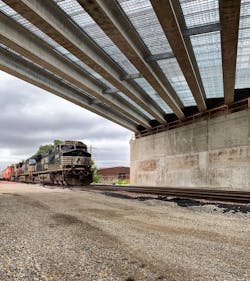A $26.4 million project on U.S. 63 in Waterloo, Iowa has turned a frequently flooded underpass at the Chicago Central and Pacific Railroad into an overpass. The overpass is the last phase of a $60 million reconstruction of U.S. 63 from the downtown intersection with U.S. Highway 218 North, to Donald Street near UnityPoint Allen Hospital. The overpass will also help emergency responders access the hospital just to the north of the project and improve vehicular and pedestrian traffic in the area.
Work commenced in fall 2017 to install an underground drainage system to alleviate the flooding, following which construction of the overpass began. Reinbeck, Iowa-based contractor Peterson Contractors Inc. (PCI) was faced with significant challenges to construct the bridge, including detailed coordination with the railroad, difficult access, short work windows and a tight timeline. PCI identified an Iowa DOT approved transparent stay-in-place form as a solution.
The use of the transparent ClearCast Forms, from TrueTech Bridge, is new to the state of Iowa, says Jacob Hamm, superintendent at PCI. ClearCast Forms are transparent stay-in-place deck forms that improve safety, speed deck placement, eliminate form stripping, and allow inspections during and after the deck pour.
This was the first time PCI had worked with ClearCast Forms to solve multiple challenges on a project. “The use of ClearCast was new to this project,” Hamm says. “When the DOT comes to inspect under the bridge, they can see if there is any deterioration,” similar to standard wood forming methods. With ClearCast, however, they can leave the forms in place.
Hamm says the project is unique in that it “started as an underpass and it became an overpass because they couldn’t control the groundwater.” Frequent flooding led crews to install underground drainage at the underpass for the railroad, then build an overpass. Where once motorists drove 22 ft under the railway tracks, they now pass 32 ft over them. The new overpass opened on schedule in November.
Working on the railroad
The U.S. 63 project was not without challenges—specifically, working around the schedule of an operational railroad.
“This project had a very tight schedule,” Hamm says. PCI was limited to when it would be allowed to work on the railway tracks. PCI sought to use stay-in-place forms to speed placement of the deck due to limited work windows above the active railroad and to avoid additional flagging time and man-hours removing the temporary wood deck formwork.
“When you were typically doing an [overpass] deck, you have to go back and remove the lumber from underneath,” Hamm says. With ClearCast Forms, this step is not necessary.
The project required significant coordination with the railroad to raise the roadway nearly 50 ft and set girders and deck while keeping the tracks in service. “The railroad is very protective,” Hamm says. “Some days we wouldn’t get any time to work on the forms. And it’s a safety issue, too. The railroad doesn’t want construction workers there if there is a train coming.”
Setting the 115-ft Bulb T-Beam girders and the decking over the active railroad required constant communication with flaggers. Tight working windows meant work had to be well-planned and executed efficiently.
With ClearCast Forms, “we didn’t have to go back and strip under the bridge,” Hamm says. “This definitely was time-saving, and that allowed us to move our crews on to other tasks on the schedule. Anytime you can install a framing system and not remove it, that saves time. We thought the stay-in-place form was worth the cost.”
Because ClearCast Forms are customized to fit each project, PCI was able to install the lightweight product quickly with a four-man crew, and without heavy equipment or specialized labor. Once the deck was poured, Peterson Contractors was able to use its crews for the remaining tasks to complete the bridge on schedule.
Policy changes
Because the use of ClearCast Forms was new to Iowa, the DOT did not have guidelines for its use until now, according to James Nelson, director of Iowa DOT’s Bridges & Structures Bureau.
“Traditionally we have not permitted the use of stay-in-place forms because you can’t inspect the concrete under the forms,” Nelson says. “We have an important role in inspections, and we want to be able to see what’s happening at the bottom of the bridge deck.”
Overall, Nelson thinks the project went well. Iowa DOT has now put criteria in its policies to allow transparent stay-in-place forms in certain circumstances, like bridges over railroads. “The railways don’t like you to interfere with operations,” Nelson says. “So, railroads are a proponent of stay-in-place forms.” Other criteria for stay-in-place forms include certain bridges spanning water, tub girder bridges, and bridges requiring top-down construction, such as utilities or obstructions inhibiting access from below.
“We at the Iowa DOT feel there are benefits to the use of the transparent stay-in-place forms in certain situations,” Nelson says. “It’s a good new innovation to watch over time.”
Similar to Iowa, ClearCast Forms have been installed for increased productivity and improved safety in other traditionally wood-forming states across the Midwest and Northwest U.S., with installations in six states and acceptance rapidly climbing.
In addition, states that currently allow stay-in-place metal forms see ClearCast Forms as a better alternative for their inspection and preservation requirements. Indiana DOT has selected ClearCast Forms for the upcoming U.S. 20 Over I-80/I-90 Indiana Toll Road project in LaPorte, Indiana, due to the visibility of the deck, a feature that was not available for states that use stay-in place forms until now.
After working with the ClearCast Forms for the first time on the Waterloo project, Hamm expects PCI to use them again with another project. “It is something we, as a company, have not used before this project,” he says. “But we have already selected ClearCast Forms on another project, similar to this one.”

